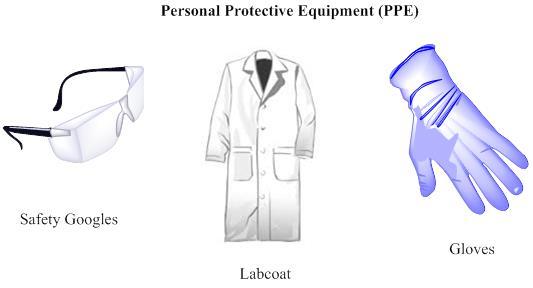Title Page
-
Conducted on
-
Prepared by
-
Building
-
Room #
-
Location
-
NOTE: This general template can be used for lab safety self-inspections. You can modify this template to suit your lab area and institution standards.
General Safety
-
Lab is maintained secure. Door is locked when no one is in lab.
-
Appropriate clothing worn by everyone in lab.
-
Personal protective equipment (PPE) (i.e. lab coats, nitrile gloves, safety glasses, etc.)
-
REFERENCE: Lab PPE to be worn
[This is an example of how you can use iAuditor to include best practice reference images in your templates to assist with inspections] -
Work and storage areas clear of clutter; access to exit is unrestricted.
-
No food or drinks found in labs.
-
Hazard sign posted on corridor door.
-
Emergency phone numbers & plan posted next to phone.
Chemical Safety
-
Eyewash not blocked; can be accessed easily.
-
Fume hood free of clutter and stored chemicals.
-
Appropriate labels are found on all hazardous chemical containers.
-
No flammable chemicals stored in regular refrigerator.
-
All compressed gas cylinders secured in upright position.
-
All compressed gas cylinders capped when not in use.
-
Shelves and chemical containers in good condition (no leaks, rust).
-
Spill control equipment (neutralizers, absorbent pads) are present.
Hazardous Waste
-
Is Hazardous chemical waste generated in this area?
-
Satellite Accumulation Area (SAA) is located at or near where waste is generated.
-
Maximum SAA storage capacity not exceeded.
-
Waste containers are in good condition (not leaking, rusted, bulging or damaged).
-
Each container is marked with the words "Hazardous Waste".
-
Each container is marked with full chemical names identifying the contents stored inside (no abbreviations or formulas).
-
Waste containers are kept closed unless adding waste.
-
Waste containers storing liquid hazardous waste at or near sinks and drains are stored within secondary containment.
-
Secondary containment is in good condition (free of cracks, gaps and impervious to leaks).
-
Is regulated medical waste or "sharps" waste generated in this area?
-
Sharps are disposed in a proper container that is kept closed unless waste is being added.
-
Regulated medical waste is placed in red bags within boxes that are properly labeled or in another suitable container
Biological Safety
-
Biological materials are not stored in hallways or chaseways in unlocked freezers or refrigerators.
-
Biohazard signs are posted in all labs handling infectious materials.
-
Lab coats, gowns or scrubs are in use in labs handling infectious materials.
-
Disinfectants are on hand for sanitizing bench tops and treating spills.
-
Biological safety cabinet(s) were certified within the last 12 months.
Radiation Safety
-
Is radioactive material present in this area?
-
Is a proper sign posted on the lab door?
-
Radioactive and/or mixed waste containers are properly labeled.
-
The GM meter(s) is calibrated.
-
The radioactive material use area is marked properly.
-
The radioactive material storage freezer is properly labeled.
-
Vials of radioactive material within a freezer are stored in a proper "lock box".
Completion
-
Any other observations
-
Inspected by








